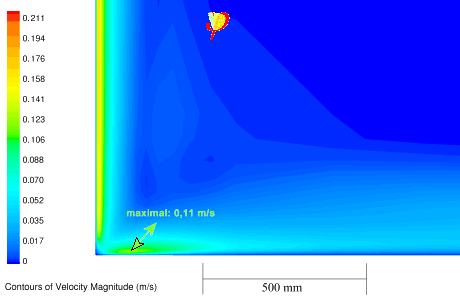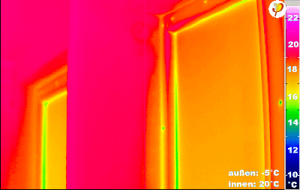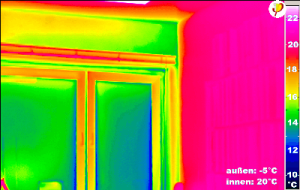Table of Contents
Thermal comfort in Passive House buildings
It is interesting that the requirements for the Passive House standard automatically meet all the criteria for thermal comfort in an optimal manner - a significantly better level of thermal insulation improves thermal comfort at the same time. This is easy to understand:
- Due to better thermal insulation (regardless of the exterior building assembly), heat flow from the inside towards the outside is reduced.
- For this reason, there is less heat flow from the indoor space towards the interior surface of that exterior building assembly. The heat flow overcomes the so-called heat transfer resistance of the surface (radiation and convection1)).
- The lower heat flow results in a lower temperature over this heat transfer resistance, in other words: the temperature difference between the room (the surfaces in the room and the room air) and the interior surface of the better insulated building assembly decreases.
The practical consequence of this is that with very well-insulated exterior building assemblies the temperature of the interior surface is only slightly different from the other temperatures in the room; this applies for the summer as well as for winter. In the cold season this means that the interior surfaces of the exterior building assemblies are also comfortably warm (exterior walls, roofs etc. are a maximum of 1 °C below the room temperature, window surfaces are a maximum of 3 to 3.5 °C below this [Pfluger 2003] ). “Passive House quality”, especially for windows is defined precisely as follows: the insulative effect of a window that is suitable for a Passive House building must be so good that
|θ Raum - θ Oberfl| ≤ 3,5 °C
holds true even with the coldest design conditions. These small temperature differences then impact all the criteria for thermal comfort in the following way:
- Air velocities in the room (with the exception of cold air flowing in through gaps - but these do not occur in Passive House buildings anyway) are generated due to buoyancy at surfaces with different temperatures. However, buoyancy forces are very small due to the low temperature differences. As a consequence, the air velocities also remain very low. Fig.1 shows the result of a simulation with a CFD2) program: there are no draughts in the occupied area, even if there is a heater under the window.
- The difference in the radiant temperatures in different directions cannot be higher than 3.5 °C if the exterior surface temperature is a maximum of only 3.5 °C below the room temperature. The thermographic images in Figures 2 to 4 show the difference between various window qualities.
- Temperature stratification of the room air between the head and feet of a seated person is less than 2 °C - but only if the effective average U-value of the exterior building assembly is below 0.85 W/(m²K). Compare the illustration on the page parameters that influence thermal comfort
- Perceived temperatures in the room differ by less than 0.8 °C from place to place.
Even in well-insulated buildings, heat losses still occur during cold periods; naturally these are very low, so that it is much easier to replace these. This must be done even in a Passive House building, of course; often the free internal heat gains such as body heat of occupants and solar radiation through windows are enough for this purpose. But even if this is not the case, the remaining heating output that is required is very small, a familiar reference value is 10 W/m². This extremely small output can then “somehow” be supplied to the indoor space - neither the exact location for this, nor a time delay even of a few hours will then play any significant role for this 3). In such a building, keeping the indoor temperature at a comfortable level should therefore hardly be a problem, even under the most difficult of circumstances.
All comfort criteria are met in an optimal way without the need for a compensating radiant heating surface. For this reason, a radiant heat climate automatically prevails in rooms in a Passive House building, regardless of how the heat is supplied. What is more, because there are no large temperature differences, there is also very little air movement. The results presented here are substantiated in the publication [Pfluger 2003] and have been repeatedly confirmed through user experiences.
Three independent research results confirm the fact that these characteristics of well-insulated building envelopes are also perceived in the same way in practice:
- Thermographic images and measurement of air temperature and air velocities in Passive House buildings have experimentally confirmed the results presented here ([Schnieders 2002]).
- Physiological measurements by Bernhard Lipp objectify the perception of comfort ([Lipp 2004]).
- Sociological surveys of a representative number of occupants have given excellent results for well-insulated buildings ([Hermelink 2004]).
See also
Types of glazing and their specific values
thermal comfort - also in summer
Overview of Passipedia articles on the topic of “Thermal comfort”
Reference literature
| [Pfluger 2003] | Pfluger, R.; Schnieders, J.; Kaufmann, B.; Feist, W.: Hochwärmedämmende Fenstersysteme: Untersuchung und Optimierung im eingebauten Zustand (Anhang zu Teilbericht A), (Super-insulated window systems: Inspection and optimisation in the installed state, Appendix to Sub-Report A), 2003, online publication (only in German) |
| [Schnieders 2002] | Schnieders, J.; Betschart, W.; Feist, W.: Raumluftströmungen im Passivhaus: Messung und Simulation (Indoor air flows in a Passive House building: Measurement and simulation) HLH 03-2002, page 61, abbreviated online version: User survey (only in German) |
| [Lipp 2004] | Lipp, B. und Moser, M.: Heizsysteme und Behaglichkeit: Ist Behaglichkeit physiologisch messbar? (Heating systems and thermal comfort: Is thermal comfort physiologically measureable?) in: Research Group for Cost-effective Passive Houses, Protocol Volume No. 25, Darmstadt, 2004, abbreviated online version: Thermal comfort |
| [Hermelink 2004] | Hermelink, Andreas: Werden Wünsche wahr? Temperaturen in Passivhäusern für Mieter (Can wishes come true? Temperatures in Passive House buildings for rental); in: Research Group for Cost-effective Passive Houses. Protocol Volume No. 25, Darmstadt, 2004, abbreviated online version: Survey of tenants |





